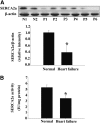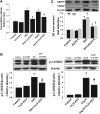CYP2J2-derived epoxyeicosatrienoic acids suppress endoplasmic reticulum stress in heart failure
- PMID: 24145329
- PMCID: PMC3868901
- DOI: 10.1124/mol.113.087122
CYP2J2-derived epoxyeicosatrienoic acids suppress endoplasmic reticulum stress in heart failure
Abstract
Prolonged endoplasmic reticulum (ER) stress causes apoptosis and is associated with heart failure. Whether CYP2J2 and its arachidonic acid metabolites [epoxyeicosatrienoic acids (EETs)] have a protective influence on ER stress and heart failure has not been studied. Assays of myocardial samples from patients with end-stage heart failure showed evidence of ER stress. Chronic infusion of isoproterenol (ISO) or angiotensin II (AngII) by osmotic mini-pump induced cardiac hypertrophy and heart failure in mice as evaluated by hemodynamic measurements and echocardiography. Interestingly, transgenic (Tr) mice with cardiomyocyte-specific CYP2J2 expression were protected against heart failure compared with wild-type mice. ISO or AngII administration induced ER stress and apoptosis, and increased levels of intracellular Ca(2+). These phenotypes were abolished by CYP2J2 overexpression in vivo or exogenous EETs treatment of cardiomyocytes in vitro. ISO or AngII reduced sarcoplasmic/endoplasmic reticulum calcium ATPase (SERCA2a) expression in hearts or isolated cardiomyocytes; however, loss of SERCA2a expression was prevented in CYP2J2 Tr hearts in vivo or in cardiomyocytes treated with EETs in vitro. The reduction of SERCA2a activity was concomitant with increased oxidation of SERCA2a. EETs reversed SERCA2a oxidation through increased expression of antioxidant enzymes and reduced reactive oxygen species levels. Tempol, a membrane-permeable radical scavenger, similarly decreased oxidized SERCA2a levels, restored SERCA2a activity, and markedly reduced ER stress response in the mice treated with ISO. In conclusion, CYP2J2-derived EETs suppress ER stress response in the heart and protect against cardiac failure by maintaining intracellular Ca(2+) homeostasis and SERCA2a expression and activity.
Figures







Similar articles
-
CYP2J2 and its metabolites (epoxyeicosatrienoic acids) attenuate cardiac hypertrophy by activating AMPKα2 and enhancing nuclear translocation of Akt1.Aging Cell. 2016 Oct;15(5):940-52. doi: 10.1111/acel.12507. Epub 2016 Jul 14. Aging Cell. 2016. PMID: 27416746 Free PMC article.
-
14,15-epoxyeicosatrienoic Acid suppresses cigarette smoke extract-induced apoptosis in lung epithelial cells by inhibiting endoplasmic reticulum stress.Cell Physiol Biochem. 2015;36(2):474-86. doi: 10.1159/000430113. Epub 2015 May 11. Cell Physiol Biochem. 2015. PMID: 25968975
-
CYP2J2 and EETs Protect against Oxidative Stress and Apoptosis in Vivo and in Vitro Following Lung Ischemia/Reperfusion.Cell Physiol Biochem. 2014;33(6):1663-80. doi: 10.1159/000362950. Epub 2014 May 16. Cell Physiol Biochem. 2014. PMID: 24903033
-
SERCA2a: a key protein in the Ca2+ cycle of the heart failure.Heart Fail Rev. 2020 May;25(3):523-535. doi: 10.1007/s10741-019-09873-3. Heart Fail Rev. 2020. PMID: 31701344 Review.
-
The cardiac sarcoplasmic/endoplasmic reticulum calcium ATPase: a potent target for cardiovascular diseases.Nat Clin Pract Cardiovasc Med. 2008 Sep;5(9):554-65. doi: 10.1038/ncpcardio1301. Epub 2008 Jul 29. Nat Clin Pract Cardiovasc Med. 2008. PMID: 18665137 Review.
Cited by
-
Antipurinergic therapy corrects the autism-like features in the Fragile X (Fmr1 knockout) mouse model.Mol Autism. 2015 Jan 13;6:1. doi: 10.1186/2040-2392-6-1. eCollection 2015. Mol Autism. 2015. PMID: 25705365 Free PMC article.
-
Ophiopogonin D maintains Ca2+ homeostasis in rat cardiomyocytes in vitro by upregulating CYP2J3/EETs and suppressing ER stress.Acta Pharmacol Sin. 2016 Mar;37(3):368-81. doi: 10.1038/aps.2015.146. Epub 2016 Feb 1. Acta Pharmacol Sin. 2016. PMID: 26838069 Free PMC article.
-
In vitro and in vivo metabolism of N-adamantyl substituted urea-based soluble epoxide hydrolase inhibitors.Biochem Pharmacol. 2015 Dec 15;98(4):718-31. doi: 10.1016/j.bcp.2015.10.013. Epub 2015 Oct 19. Biochem Pharmacol. 2015. PMID: 26494425 Free PMC article.
-
CYP2J2 metabolites, epoxyeicosatrienoic acids, attenuate Ang II-induced cardiac fibrotic response by targeting Gα12/13.J Lipid Res. 2017 Jul;58(7):1338-1353. doi: 10.1194/jlr.M074229. Epub 2017 May 29. J Lipid Res. 2017. PMID: 28554983 Free PMC article.
-
The traditional Chinese medicines treat chronic heart failure and their main bioactive constituents and mechanisms.Acta Pharm Sin B. 2023 May;13(5):1919-1955. doi: 10.1016/j.apsb.2023.02.005. Epub 2023 Feb 11. Acta Pharm Sin B. 2023. PMID: 37250151 Free PMC article. Review.
References
-
- Adachi T, Weisbrod RM, Pimentel DR, Ying J, Sharov VS, Schöneich C, Cohen RA. (2004) S-Glutathiolation by peroxynitrite activates SERCA during arterial relaxation by nitric oxide. Nat Med 10:1200–1207 - PubMed
-
- Biagioli M, Pifferi S, Ragghianti M, Bucci S, Rizzuto R, Pinton P. (2008) Endoplasmic reticulum stress and alteration in calcium homeostasis are involved in cadmium-induced apoptosis. Cell Calcium 43:184–195 - PubMed
-
- Cohen RA, Adachi T. (2006) Nitric-oxide-induced vasodilatation: regulation by physiologic s-glutathiolation and pathologic oxidation of the sarcoplasmic endoplasmic reticulum calcium ATPase. Trends Cardiovasc Med 16:109–114 - PubMed
-
- Cohen RA, Weisbrod RM, Gericke M, Yaghoubi M, Bierl C, Bolotina VM. (1999) Mechanism of nitric oxide-induced vasodilatation: refilling of intracellular stores by sarcoplasmic reticulum Ca2+ ATPase and inhibition of store-operated Ca2+ influx. Circ Res 84:210–219 - PubMed
-
- Deniaud A, Sharaf el dein O, Maillier E, Poncet D, Kroemer G, Lemaire C, Brenner C. (2008) Endoplasmic reticulum stress induces calcium-dependent permeability transition, mitochondrial outer membrane permeabilization and apoptosis. Oncogene 27:285–299 - PubMed
Publication types
MeSH terms
Substances
Grants and funding
LinkOut - more resources
Full Text Sources
Other Literature Sources
Medical
Molecular Biology Databases
Miscellaneous

